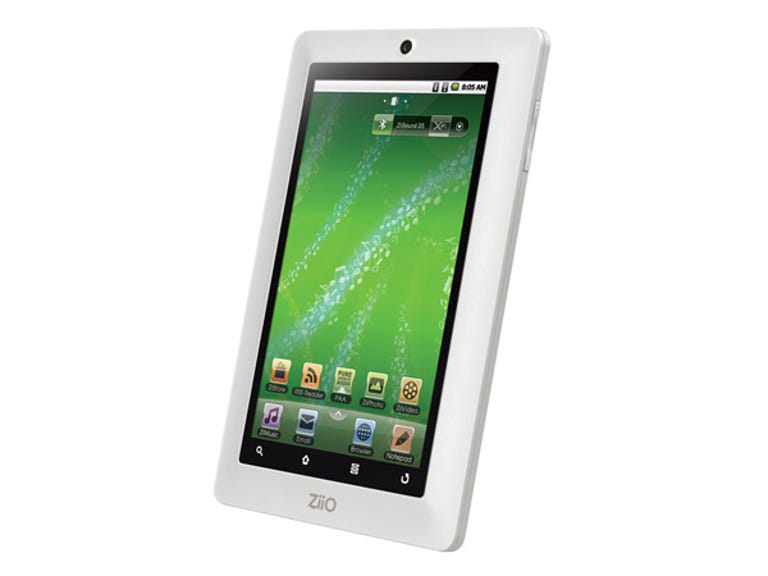 Why You Can Trust CNET
Why You Can Trust CNET Creative ZiiO 7 review: Creative ZiiO 7
The Creative ZiiO 7 is a device that seems to be trying too hard to be a jack of all trades — and unfortunately ends up being merely mediocre at all of them.
What do you want in a tablet computer? Before you rush out and spend your hard-earned AU$300 on the Creative ZiiO 7, you might want to think long and hard about that question. We've had our hands on the device for a few weeks now, and it is resolutely failing to impress.
The Good
The Bad
The Bottom Line
Creative has billed the ZiiO as "the next evolution in wireless digital entertainment and mobile computing". It would be good to have something nice to say about this statement, but the claim is, well, laughable. Sporting a low-res 480x800p resistive touchscreen, which may be cheaper to make but is a step backwards compared to slicker and faster capacitive screens, and the older Android 2.1 OS, it might have been something we oohed and aahed over three years ago. Now it's just a bit sad.
Design
Out of the box, the ZiiO has a nice heft to it; at 415g, it's a little weightier than the Samsung Galaxy Tab or the Optus MyTab, but still falls within a decent weight range. The pearlised white plastic case is fine, but the part you'll be looking at the most — the screen — looks, made as it is of glossy plastic, tacky.
Working our way around the outside, we find ports for mini USB, HDMI and 3.5 audio, as well as a slot for microSD. Two speakers are discreetly placed on the back of the device, while a front-facing VGA camera and microphone sit up the top, enabling the tablet for Skype calls (provided you're Wi-Fi connected).
The ZiiO does come with an included stylus, but, vexingly, the device itself doesn't have a slot into which you can handily place the stylus. If you don't want your stylus to go wandering off in the bowels of your bag, or get left behind on your couch, you will probably need to pony up for a protective case — an additional 50 bucks for the official one. Yikes.
Features
Specs-wise, the ZiiO ticks all the boxes: 7-inch back-lit LCD screen, Android OS, HDMI, Bluetooth and Wi-Fi, USB and microSD. Even the resistive screen, in spite of seeming like a slightly outdated choice, works well enough. It isn't running the latest version of Android and isn't Mac OS-compatible, but the Wi-Fi means you can do most things from the device itself anyway.
It also doesn't include Flash right off the bat; however, unlike the iPad, you can download it for a compatible browser. The browser included in the ZiiO is a proprietary one, but the Opera browser we downloaded and tested worked OK. We didn't really like the lack of tabbed browsing, and the touchscreen performs sluggishly at times, but that doesn't really matter — much — for typing. Any apps, however, that are dependent on touch function will probably be quite annoying to use.
Performance
Unfortunately, using the device itself is a minefield of frustration. Firstly, the firmware refused to update, saying it was "incompatible" with the hardware. The fifth try finally saw success. Then it was time to download some apps. The ZiiO doesn't have access to the full Android marketplace — possibly because not all the apps have been optimised for the ZiiO (although the Pac-man app we tested hadn't been resized properly and sat awkwardly, phone-screen-sized, in the top left corner of the screen) — but you can visit the ZiiO Space via the device. You can't, however, download any apps unless you register your device first. It took three days for our confirmation email to arrive containing log-in information.
After two days of using apps, most of the apps started crashing before fully booting up; a factory reset restored things to rights, but only after hunting around for the factory reset option, which was found in the privacy settings menu. And, of course, all the apps had to be reloaded.
Battery life is also a bit hit and miss; we used the device for three days without charging initially, which reduced the battery to about 30 per cent. One night, we left it in a drawer on full charge; after using it for 20 minutes the next day, the battery was completely drained.
We also, in spite of the HDMI output, could not get it to recognise that an HDMI cable was, in fact, connected.
Conclusion
The ZiiO actually performs fine when it's not driving you up the wall, even though the screen looks cheap and choppy, but we honestly couldn't come up with a compelling reason someone would want it. It's a device that seems to be trying too hard to be a jack of all trades — and unfortunately ends up being merely mediocre at all of them. It's in the less pricey tablet range, so if you're absolutely desperate for a tablet, it might do, in a pinch; but the experience will leave you feeling as though that AU$300 might have been a bit more wisely invested.


